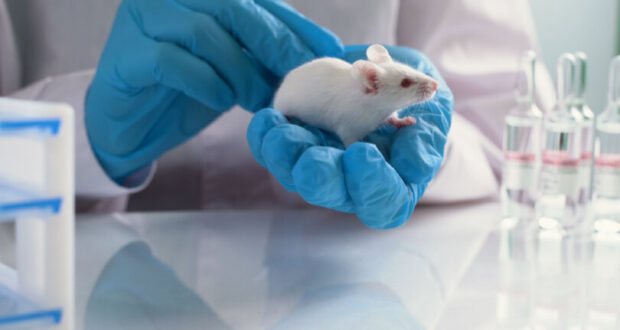📌 خداع وكذب وأبيهم “أبو الكذب”.. ينشرون العقم باللقاحات ويدّعون أنهم يسعون علاج أشكال العقم…
📌يدعون حماية البيئة والطبيعة ويتلاعبون بطبيعة البشر.. “وماذا عن الطفل؟ وليس هناك ما يضمن أن الطفل لن يتضرر من مثل هذا التلاعب البيولوجي… !! ومن بعدا بتِطلّع محامية تُشبه “فايزر” وتعتذر.. وتضع الحق عَ الحكومة يللي راحِت (لحقا يا شاطر).. إنّو هيك طلبوا منها!!
📌 بغضّ النظر عن الإعلان الإعلامي.. قد لا يكون هذا الأمر حقيقي/واقعي ككثيرٍ من النظريات المُتلطية خلف العلم من دون إثبات، مصداقيتهم Zero.. ونواياهم إبليسية هدفهم إدعاءهم أنهم كالله يخلقون، والبشر يُصطادون بحب الفضول والحشرية.. (Agoraleaks)
Emily Mangiaracina – من غير المؤكد ما إذا كان من الممكن أيضًا تكوين خلايا البويضات من خلايا الجلد البشري الذكرية ، لكن العلماء يحاولون بالفعل تحقيق ذلك ، بحيث يمكن لرجلين تكوين طفل وراثيًا ، على سبيل المثال.
نجح علماء في اليابان في تربية فأر مع أبوين وراثيين من خلال تحويل خلية جلد ذكر إلى خلية بويضة ، مما أثار مخاوف أخلاقية بشأن إمكانية استخدام هذه التقنية على البشر.
أعلن كاتسوهيكو هاياشي ، عالم الأحياء بجامعة أوساكا ، الأسبوع الماضي أن فريقه ساعد في إنجاب سبعة فئران “صحية” باستخدام “أبوين” وراثيين في كل حالة ، مما يمثل “الحالة الأولى لصنع ثدييات قوية [بيض] من الذكور الخلايا “.
تم إنجاز هذا العمل الغريب أولاً عن طريق تحويل خلايا الجلد الذكرية إلى خلايا جذعية محفزة (iPS) ، وتم حذف كروموسومات Y الخاصة بها واستبدالها بكروموسوم X “مستعار” من خلية أخرى.
“الحيلة في هذا ، أكبر خدعة ، هو تكرار الكروموسوم X ،” قال هاياشي ، حسبما ذكرت صحيفة الغارديان.
ثم تمت زراعة هذه الخلايا XX iPS في عضوي المبيض ، وهو نظام استزراع مصمم لتكرار الظروف داخل مبيض فأر ، قبل تخصيبها بالحيوانات المنوية. تم زرع الأجنة الناتجة البالغ عددها 600 في فئران أم بديلة ، وظل سبعة من 600 فأر على قيد الحياة حتى الولادة وحتى لديهم “عمر طبيعي” واستمروا في أن يصبحوا آباءً.
قال هاياشي إن الفئران الصغيرة “تبدو بحالة جيدة” ويبدو أنها “تنمو بشكل طبيعي” ، لكنه لم يخاطب علنًا ما إذا كان هناك تشوهات أو عيوب لم تكتشف بعد في نسل الفئران.
يتم بالفعل محاولة مثل هذه التقنيات لتصور البشر. قام سام ألتمان ، وهو مثلي جنسي شارك في تأسيس OpenAI مع Elon Musk ، بالاستثمار في شركة تسمى Conception ، والتي “تخطط لزراعة بويضات بشرية قابلة للحياة من الخلايا الجذعية ويمكن أن تسمح لذكرين بيولوجيين بالتكاثر” ، وفقًا لـ Business Insider exposé ، شارك محرر “غرفة الحرب” جو ألين على تويتر.
أطلق ألين على نسل الفئران لقب “Gaybies”.
يعمل فريق Hayashi الآن أيضًا على تكرار إنجازاتهم على البشر. يعتقد هاياشي أن التكنولوجيا اللازمة لإنشاء بويضة بشرية قابلة للحياة من خلية جلد ذكر ستكون متاحة في غضون 10 سنوات ، على الرغم من أن آخرين أشاروا إلى أن هذا له عقبات إضافية كبيرة في الخلايا البشرية.
قال البروفيسور أماندر كلارك، الذي كان من أوائل الذين ساعدوا في تطوير خلايا iPS في جامعة كاليفورنيا لوس أنجلوس ، إن تحقيق نتائج Hayashi في الخلايا البشرية سيكون “قفزة هائلة” لأن العلماء لم يتمكنوا بعد من تكوين بويضات بشرية ناضجة حتى من الخلايا الأنثوية في المختبر.
كان العلماء حتى الآن قادرين فقط على إنشاء السلائف لخلايا البويضات ، حيث توقفت خلاياهم التجريبية عن التطور قبل الانقسام الاختزالي ، وهو الانقسام الخلوي الأساسي لتكوين الأمشاج.
قال كلارك: “نحن على أهبة الاستعداد في الوقت الراهن”. “الخطوات التالية تمثل تحديًا هندسيًا. لكن تجاوز ذلك قد يستغرق 10 سنوات أو 20 سنة “.
وأشار آخرون إلى أن الطول الطويل اللازم لإنتاج بويضة بشرية ناضجة يزيد من مخاطر التشوهات الجينية.
قال هاياشي إن الدافع الرئيسي لأبحاثه البشرية هو قدرتها على علاج أشكال العقم 😉، حيث يكون لدى النساء نسخة واحدة من كروموسوم X مفقودة أو مفقودة جزئيًا.
ومع ذلك ، فإنه يرحب أيضًا باستخدام هذه التقنية للسماح لرجلين بأب لطفل وراثيًا إذا ثبت أنها آمنة.
يقال إن علماء آخرين يأملون في أن تفتح مثل هذه الطريقة الباب أمام الأطفال الوحيدين.
أثار المؤلف ويسلي سميث مخاوف بشأن سلامة ورفاهية الأطفال الذين تم إنجابهم بهذه الأساليب وأشار إلى مخاوف أخلاقية أخرى تحيط بتقنية الإنجاب.
“وماذا عن الطفل؟ ليس هناك ما يضمن أن الطفل لن يتضرر من مثل هذا التلاعب البيولوجي…
وأشار أيضًا إلى أن التجارب المطلوبة لإثبات سلامة مثل هذا الإنجاب المُتلاعب به “من المؤكد تقريبًا أن تتضمن عمليات إجهاض متكررة أو ولادة جنين ميت أو أطفال يولدون بعيوب خلقية” “إلى تقنيات متقنة”.
“لأننا قد نكون قادرين على اكتشاف كيفية تحريف الطبيعة في عقدة لا يعني ذلك أننا يجب أن نفعل ذلك. قال سميث: “لقد مضى وقت طويل بسبب التنظيم القانوني للتجارب البشرية في هذا المجال من التكنولوجيا الحيوية قبل فوات الأوان”.
تم تربية الفئران سابقًا والتي تحمل المادة الوراثية لاثنين من الآباء البيولوجيين التقنيين من خلال سلسلة خطوات معقدة ومتعددة الأجيال لا يزال فيها الفأر الأم متورطًا في الحمل ، لكن العلماء لم ينجحوا في تكوين خلية بويضة من الخلايا الذكرية حتى الآن .
Scientists breed mice with two males, no females through method that could lead to human ‘gaybies’
Emily Mangiaracina It’s uncertain whether egg cells can likewise be created from male human skin cells, but scientists are already attempting to achieve this, so that two men could genetically create a child, for instance.
Scientists in Japan have successfully bred a mouse with two genetic fathers by turning a male skin cell into an egg cell, raising ethical concerns regarding the technique’s potential use on humans.
Katsuhiko Hayashi, a biologist at the University of Osaka, announced last week that his team had helped conceive seven “healthy” mice pups using two genetic “fathers” in each case, marking the “first case of making robust mammal [eggs] from male cells.”
The strange feat was accomplished first by turning male skin cells into induced pluripotent stem (iPS) cells, and these cells in turn had their Y chromosomes deleted and replaced by an X chromosome “borrowed” from another cell.
“The trick of this, the biggest trick, is the duplication of the X chromosome,” said Hayashi, The Guardian reported.
These XX iPS cells were then “cultivated in an ovary organoid, a culture system designed to replicate the conditions inside a mouse ovary,” before being fertilized with sperm. The 600 resulting embryos were implanted into surrogate mother mice, with seven of the 600 mice surviving to birth and even having a “normal lifespan” and going on to become fathers themselves.
Hayashi said the baby mice “look OK” and appear to be “growing normally,” but has not publicly addressed whether there may be yet-undiscovered abnormalities or defects in the offspring mice.
Such techniques are already being attempted to conceive human beings. Sam Altman, a homosexual who co-founded OpenAI with Elon Musk, has invested in a company called Conception, which “plans to grow viable human eggs out of stem cells and could allow two biological males to reproduce,” according to a Business Insider exposé, War Room transhumanism editor Joe Allen shared on Twitter.
Allen dubbed the mice offspring “Gaybies.”
Hayashi’s team is also now working to replicate their achievement in humans. Hayashi believes the technology needed to create a viable human egg from a male skin cell will be available in 10 years, although others have pointed out that this has significant added hurdles in human cells.
Professor Amander Clark, who was one of the first to help develop iPS cells at the University of California Los Angeles, said that achieving Hayashi’s results in human cells would be a “huge leap” because scientists have not yet been able to create mature human eggs even from female cells in a lab.
Scientists have until now only been able to create the precursors to egg cells, as their experimental cells have stopped developing before meiosis, the cell division that is key to creating gametes.
“We’re poised at this bottleneck at the moment,” Clark said. “The next steps are an engineering challenge. But getting through that could be 10 years or 20 years.”
Others have pointed out that the greater length of time needed to potentially produce a mature human egg increases the risk of genetic abnormalities.
Hayashi has said that the main motivation for his human research is its potential to treat forms of infertility such as Turner’s syndrome, in which women have one copy of the X chromosome missing or partly missing.
However, he would also welcome the technique’s use to allow two men to genetically father a child if it were shown to be safe.
Other scientists reportedly hope such a method could open the door to single-parent children.
Author Wesley Smith has raised concerns about the safety and well-being of the babies conceived by such methods and has pointed to other ethical concerns surrounding the procreative technique.
“And what about the baby? There is no assurance that the baby would not be harmed by such biological manipulation. Or, is that a secondary concern to the great contemporary maw of ‘I want?’” Wesley protested in National Review.
He also pointed out that the experiments required to demonstrate the safety of such manipulated procreation would “almost surely involve repeated abortions, stillbirths, or babies born with birth defects” “to perfect techniques.”
“Because we might be able to figure out how to twist nature into a knot doesn’t mean that we should. The time is long past due to legally regulate human experiments in this field of biotechnology before it is too late,” Smith said.
Mice have previously been bred that carry the genetic material of two technical biological fathers through an elaborate, multi-generational chain of steps in which a mother mouse is still involved in conception, but scientists have not successfully created an egg cell from male cells until now.
 Agoraleaks Agoraleaks
Agoraleaks Agoraleaks







